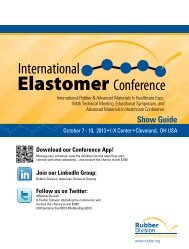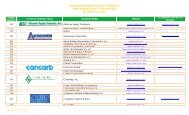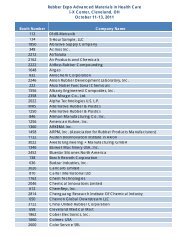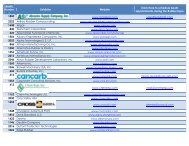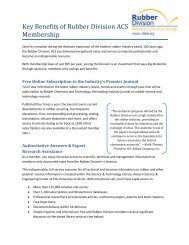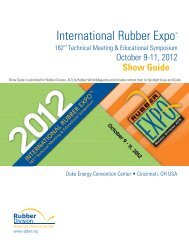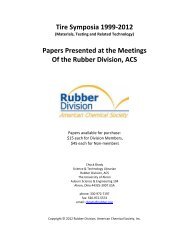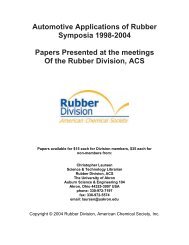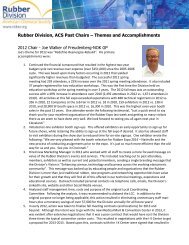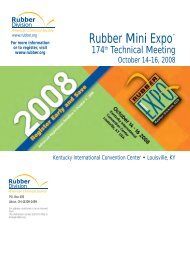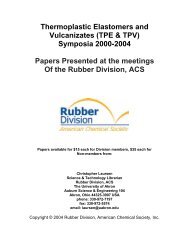Training Directory - Rubber Division
Training Directory - Rubber Division
Training Directory - Rubber Division
Create successful ePaper yourself
Turn your PDF publications into a flip-book with our unique Google optimized e-Paper software.
PROPERTIES, ANALYSIS & TESTING<br />
Compounding, Mixing, Curing<br />
and Testing of <strong>Rubber</strong><br />
12 hours<br />
CEUs: 1.2<br />
This two-day course covers an Introduction to Polymer<br />
Science: NR, SBR and Polybutadiene <strong>Rubber</strong>; Introduction to<br />
Compounding: Mixing, Carbon Black, Vulcanization, Specialty<br />
Elastomers, Tack and Adhesion; and the Physical Testing of<br />
Elastomer Procedures and Signifi cance. There is also a group<br />
discussion and problem solving session.<br />
Anyone interested in an introductory seminar on rubber<br />
should attend.<br />
Testing of <strong>Rubber</strong>: Selecting,<br />
Performing and Interpreting<br />
ASTM <strong>Rubber</strong> Test Methods<br />
8 hours<br />
CEUs: .8<br />
Be sure to attend this two-day seminar which reviews the most<br />
commonly used rubber test procedures in the rubber industry<br />
today. It also discusses the nature of tests, why the tests are<br />
performed, interoretation and how this information can be used<br />
to improve rubber fabrication. This course covers all the major<br />
physical and chemical tests, as well as various standard practices.<br />
The seminar is ideal for a wide variety of individuals including:<br />
rubber technologists, rubber chemists, compounders, process<br />
engineers, laboratory technicians, supervisors and managers,<br />
quality assurance managers and engineers, shop foremen,<br />
technical salespeople, rubber producers and users, or anyone with<br />
the need to understand these commonly used ASTM methods.<br />
Key To Symbols<br />
Online Registration<br />
Certifi cate/CEUs Awarded<br />
On-site<br />
E-learning<br />
International<br />
Mixing and Testing for Compounding<br />
Consistency<br />
6 hours<br />
CEUs: .6<br />
This seminar will provide specifi c details describing control of<br />
the mixing process and the testing procedures to measure the<br />
effectiveness of this control. Compound properties and quality<br />
are always the fi rst concerns of product designers, producers<br />
and users – the product must meet performance specifi cations.<br />
However, once quality criteria have been determined, the job of<br />
the mixer is to guarantee and deliver a compound with uniformity<br />
and consistency meeting these specifi cations. Attendees will gain<br />
or expand their understanding of this process amongst others.<br />
“Mixing and Testing for Compound Consistency” will provide:<br />
• material control concepts.<br />
• mixing techniques.<br />
• tests designed to relate to compound consistency.<br />
• statistical treatment of mixing and test data.<br />
This seminar will benefi t mixing managers and supervisors,<br />
quality control engineers and laboratory managers and supervisors.<br />
Introduction to Compounding<br />
and Testing of Elastomers<br />
8 hours<br />
CEUs: .8<br />
This seminar will present an overview of compounding elastomers.<br />
It will present a description and review of the functionality of<br />
the various compounding ingredients used to formulate a rubber<br />
compound, their advantages and disadvantages, in order to<br />
achieve a desired level of compound performance properties.<br />
Materials discussed include elastomers, fi llers, curing agents,<br />
plasticizers and antioxidants.<br />
This is an applied seminar which emphasizes practical approaches<br />
to real world compounding problems. Theory and mechanisms<br />
are presented where they are helpful to allow the compounder<br />
to develop a model to predict behavior and responses.<br />
The objectives of this seminar:<br />
• provide overview of practical aspects of compounding<br />
elastomers<br />
• provide help in selecting elastomers<br />
• provide opportunities for one-on-one dialog beyond<br />
general class interest<br />
• utilize class expertise as a resource<br />
• provide references/contacts for you to use as future<br />
questions arise<br />
10 RUBBER DIVISON, ACS EDUCATION OPPORTUNITIES



